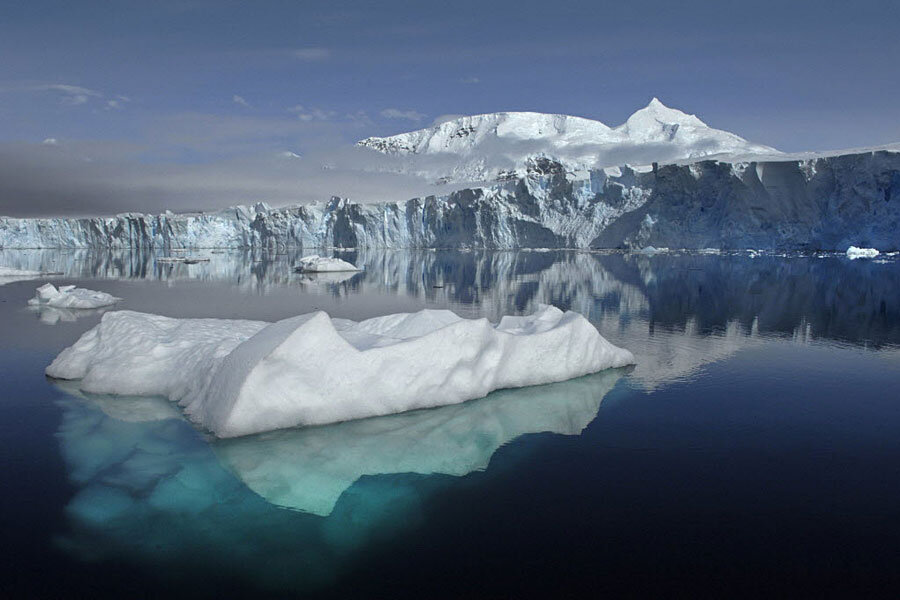How huge icebergs could be slowing climate change
Loading...
All else being equal, global warming means more giant icebergs breaking off Antarctica and sliding into the ocean. But, as these massive hunks of ice float around the Southern Ocean, their meltwater is stimulating a process that is fighting back.
As icebergs slowly melt into the sea, they deposit nutrients, such as iron, that fertilize phytoplankton, the microscopic marine plants that live at the water's surface. Blooms of phytoplankton consume carbon dioxide through photosynthesis, which takes the carbon out of the atmosphere, which in turn slows global warming.
Scientists have known about this phenomenon for years, but a new study suggests giant icebergs, stretching over 11 miles long, could be responsible for 10 to 20 percent of carbon sequestration the Southern Ocean.
"It's another component of the climate change story," Grant R. Bigg, a professor in Earth systems science at the University of Sheffield and the author of the new study, tells The Christian Science Monitor in an interview. "If giant icebergs hadn't existed, then the carbon dioxide in the atmosphere would have gone up even more than it currently has. It's been something which has helped to slow down the rate of increase of carbon dioxide and therefore climate change."
Dr. Bigg and his colleagues tested the impact of this phenomenon by analyzing satellite images of 17 giant icebergs and the colorful plume surrounding them. The plume, colored by the elevated chlorophyll levels of the phytoplankton blooms, stretched out some four to 10 times the iceberg's length and could last for over a month after the iceberg passed by. Their findings are described in an article published Monday in the journal Nature Geoscience.
Are icebergs going to save us from climate change?
No, says Ronald S. Kaufmann, a marine and environmental scientist at the University of San Diego who is not associated with the study, but who has researched this phenomenon. "I would hate for somebody to look at this and say, see it's a negative feedback, we can do whatever we want and it's not going to have an effect," he tells the Monitor in an interview.
"This is moving the needle back in the other direction, there's no question about that," Dr. Kaufmann says. "But, whether it's moving it far enough and fast enough that people will still be able to produce lots and lots of greenhouse gases without worrying about the impacts of climate … I don't think this is going to offset the burning of coal, for example."
Bigg agrees, "This isn't a large enough effect to take all the carbon dioxide out that's put in, but it will slow down that rate of increase."
But as scientists make predictions about future climate change, it's important for them to understand the impact of this phenomenon, both scientists say.
"The Southern Ocean, and specifically things like the Southern Ocean carbon cycle, are still not really well understood," Kaufmann says.
The story of icebergs and carbon sequestration
Icebergs aren't just giant ice cubes floating around in the ocean, Kaufmann says. They're more complex. The humongous frozen masses start as snow falling on the Antarctic continent. Over thousands of years that snow amasses into a gigantic glacier.
Glaciers flow, like molasses, over the continent. As they travel, glaciers rub and churn against the ground, actually incorporating some of the rock and soil into the ice crystals. That's how a glacier picks up nutrients, like iron.
Eventually, a glacier will reach the coast and stretch out over the water in an ice shelf. Icebergs are created when pieces of that shelf break off and float away into the ocean.
Out in the open ocean, wind, current and warmer temperatures erode the iceberg. As it bobs around in the Southern Ocean, the iceberg ends up leaving a trail of iron-rich meltwater.
In the Southern Ocean, iron is thought to be a limiting nutrient for phytoplankton productivity. So such a large influx of iron stimulates a bloom of the tiny plants.
As phytoplankton grow, they extract carbon dioxide from the atmosphere and incorporate it into their own cellular material. That carbon might get sequestered when the plant dies and sinks down to the depths of the ocean, or might be carried into the deep by the excrement of an animal that consumes the tiny plants. With the carbon buried in the ocean sediments, it's out of the global carbon cycle indefinitely.
Should we just sprinkle iron directly in the water?
Scientists are already puzzling over such intentional techniques to enhance carbon sequestration. But, Kaufmann says, "We don't really know what the effects on the ecosystem would be."
Phytoplankton are at the bottom of the food chain. Increasing the growth of the tiny plants could mean an increase in the organisms that consume them, producing an effect throughout the ecosystem. So, Kaufmann says, more scientific testing is necessary.
"But, of course, this kind of stuff has been happening naturally for as long as icebergs have been breaking off and drifting off into the ocean," he says.








